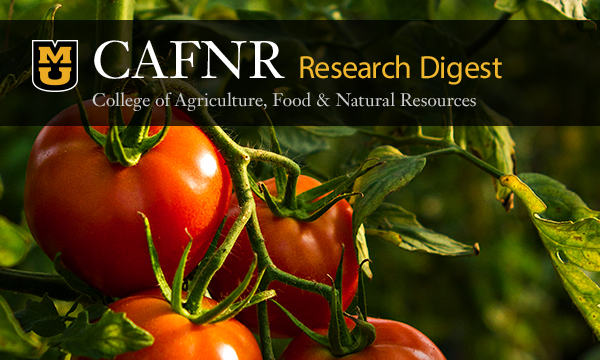|
CAFNR research included in NIFA annual report
The National Institute of Food and Agriculture (NIFA) Annual Report was published earlier this month. Research from the following CAFNR faculty was included in that report:
- Peter Sutovsky, page 7, Zinc Plays Vital Role in Animal Fertility
- Mengshi Lin, page 21, Detecting and Separating Chemical and Biological Contaminants
- Jerry Taylor, JaeWoo Kim, and Susanta Behura, page 25, Teaming Up to Stop a Worldwide Disease
CAFNR faculty members have received the following recent grants (listed by Principal Investigator):
Alba Argerich, Invertebrate Community Response to Substrate Augmentation, 7/1/2018 – 6/30/2020, $58,500, Missouri Department of Conservation
Andrew Biggs, Cooperative Agreement MDC and Bradford, 6/16/2017 – 6/30/2020, $25,000, Missouri Department of Conservation
Kaitlyn Bissonnette, Applied Management of Fusarium Head Blight in Missouri Soft Red Winter Wheat, 5/1/2019 – 4/30/2020, $10,174, Agricultural Research Service
Felix Fritschi, Climate Adaptation and Sustainability in Switchgrass: Exploring Plant-Microbe-Soil Interactions across Continental-scale Environmental Gradients, 8/15/2015 – 8/14/2020, $273,726, University of Texas Austin
Michael Gold, Integrating Agroforestry into Small Farm Production Systems, 7/1/2016 – 6/30/2021, $959,302, Agricultural Research Service
Damon Hall, Collaborative Research: ABI Innovation: Improving High-performance Supercomputer Aquatic Ecosystem Models with the Integration of Real-Time Citizen Science Data, 3/1/2019 – 6/30/2020, $11,329, St. Louis University
Antje Heese-Peck, Roles of Epsin1-dependent Clathrin-coat in Plant Immunity Against Bacteria, 8/1/2018 – 7/31/2020, $210,637, NSF Division of Integrative Organismal Systems
James Kaufman, Biogas Digestion: Economic and Asset Assessment for Missouri, 7/8/2019 – 3/16/2020, $84,049, Missouri Agriculture and Small Business Development Authority
Benjamin Knapp, Do Forest Health Issues in Oak Forests of the Eastern US Accelerate Compositional Shifts to non-Oak Species?, 7/24/2018 – 8/31/2020, $36,680, Forest Service
Benjamin Knapp, Silvicultural Options for Improving the Quality and Composition of Mixed Bottomland Hardwood Forests of Northern Missouri, 7/1/2014 – 6/30/2020, $37,390, Missouri Department of Conservation
Carol Lorenzen, Using Metabolomics to Predict and Guarantee Beef Flavor for the Consumer, 5/1/2019 – 5/31/2020, $96,525, 8/1/2019 – 7/31/2023, National Cattlemen’s Beef Association
Craig Paukert, Missouri Cooperative Fish & Wildlife Research Unit, 7/1/2019 – 6/30/2020, $60,000, Missouri Department of Conservation
Jon McRoberts, Survival, Recruitment, and Movement Patterns of White-tailed Deer in Missouri, 7/1/2014 – 6/30/2020, $157,426, Missouri Department of Conservation
Calvin Meeks, Field Trial to Evaluate RKN/RN Resistance, 5/1/2019 – 12/31/2019, $30,392, Dow AgroSciences LLC
Ron Mittler, Leaf-To-Leaf Communication During Acclimation to Multiple Stresses, 8/1/2019 – 7/31/2023, $551,298, NSF Division of Integrative Organismal Systems
Kelly Nelson, Task Order Project No. 4, 6/1/2019 – 5/31/2022, $141,862, Agresearch
Rebecca North, Algae, Stench, and Death: Are Algal Toxins Present in Missouri Fish?, 6/18/2019 – 6/17/2020, $21,085, US Geological Survey
Scott Peck, Proteomic Analysis of Wound-Induced Phosphorylation in Plants, 5/7/2019 – 3/31/2020, $4,520, RIKEN
Randall Prather, Gene Therapy for Cystic Fibrosis Lung Disease, 6/1/2019 – 5/31/2020, $58,262, University of Iowa
Jon Simonsen, Expanding Farming Benchmarking Results through Multi-state Collaborations and Mentoring, 9/1/2019 – 8/31/2020, $499,957, National Institute of Food and Agriculture
Reid Smeda, Monsanto Service Order #112, 4/1/2019 – 3/31/2020, $7,315, Monsanto
Reid Smeda, Monsanto Service Order #114, 5/1/2019 – 4/30/2020, $19,950, Monsanto
Reid Smeda, Monsanto Service Order #115, 5/1/2019 – 4/30/2020, $19,950, Monsanto
Reid Smeda, Monsanto Service Order #116, 5/1/2019 – 4/30/2020, $19,950, Monsanto
Gary Stacey, Identification of Physiological Function and Signaling Pathway of eATP Receptor, 1/1/2018 – 12/31/2020, $56,400, Gyeongsang National University
Gary Stacey, DORN1 Defines a New Family of Receptor Kinase Purinorecptors (P2K), 8/1/2017 – 7/31/2020, $294,890, NIH National Institute of General Medical Sciences
Peter Sutovsky, Linking Fertility-Associated Gene Polymorphisms to Aberrant Sperm Phenotypes, 9/12/2016 – 5/31/2020, $249,428, NIH National Institute of Child Health and Human Development
Jinglu Tan, INFEWS: US-China – Modeling and Determination of Photosynthetic Water Needs and Development of Smart Irrigation Systems to Minimize Water and Energy Use in Food Crop Production, $500,000, NSF Division of Chemical, Bioengineering, Environmental and Transport Systems
Frank Thompson, Determining the effect of habitat management and landscape context on northern bobwhite (Colinus virginianus) juvenile survival, habitat selection and population demographics in southwestern Missouri, 7/1/2016 – 6/30/2020, $48,300
Corinne Valdivia, Rural Small Business Recovery and Resilience to Natural Hazards: A Focus on Women and Minority-Owned Small Businesses, 6/15/2019 – 6/14/2022, $98,911, Purdue University
Gary Weisman, Novel Role for the P2Y2 Receptor in the Autoimmune Disease Sjogren’s Syndrome, 9/22/2016 – 8/31/2020, $623,962, National Institute of Dental and Craniofacial Research
William Wiebold, Grape and Wine Institute FY20, 7/1/2019 – 6/30/2020, $856,467, Missouri Department of Agriculture
Bing Yang, Genome-enabled Platforms for Yam, 12/1/2018 – 3/31/2020, $165,038, 12/1/2018 – 3/31/2020, Iowa State University
Provided by the MU Office of Research
|
